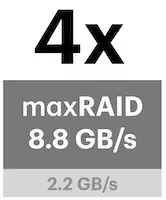Abstract
Host FTL changes how your SSDs perform, offering seamless, sustained speed regardless of your workload’s intensity. Experience optimized performance, extended SSD lifespan, and reduced costs tailored for high-demand environments such as AI, databases, and cloud services. This paper examines how Host FTL transforms SSD storage, delivering unmatched scalability and efficiency for critical workloads. Unlike traditional SSD architectures, Host FTL leverages the host system’s superior processing capabilities to implement advanced data management features, unlocking remarkable storage performance and cost efficiency.
Introduction
In today’s fast-paced, data-driven world, storage that can keep up with increasingly complex and demanding workloads is paramount. Whether supporting databases for financial transactions, training AI models, or managing large-scale cloud environments, the performance of your storage system is fundamental to operational success.
Solid-state Drives (SSDs) have revolutionized data storage with their high speed and low latency. However, traditional storage architectures—particularly those employing RAID configurations originally designed for spinning disks—fail to fully utilize SSDs’ potential. These limitations become even more pronounced as SSD arrays fill up, leading to significant write amplification, data fragmentation, and a steep decline in performance. Traditional RAID setups often struggle to meet the demands of modern storage environments, especially in write-heavy workloads. Parity calculations and inefficient data handling exacerbate these issues, resulting in higher latency and reduced ROI for organizations relying on RAID-based SSD solutions.
This white paper introduces a cutting-edge solution: Host-based Flash Translation Layer (Host FTL). Host FTL transforms how SSDs manage data by offloading the Flash Translation Layer (FTL) from SSD hardware to the host system, leveraging the host’s superior processing power. With real-time data compression, write optimization, and dynamic block management, Host FTL sustains peak performance as arrays fill up, extends SSD life, and maximizes storage capacity. The outcome? A storage infrastructure that is faster, more efficient, and far more cost-effective, both now and over time.
Host FTL in Action: Redefining How SSDs Operate
With Host FTL, every operation—be it a write, read, or data management task—is conducted more intelligently and efficiently. Offloading FTL operations to the host’s more powerful CPU and memory resources enables advanced data management techniques that enhance SSDs’ speed and endurance across the board.
1. Real-Time Compression
Host FTL performs real-time compression on data before it’s written to SSDs. This reduces the amount of data that needs to be stored, significantly increasing each drive’s effective storage capacity. By reducing the amount of data written, Host FTL minimizes write amplification, one of the key contributors to SSD wear and performance degradation. For example, in database environments with high transaction volumes, real-time compression allows organizations to reduce physical storage requirements by as much as 50% or more, enabling faster query response times and improved customer experience.
This enhances performance in write-heavy workloads and helps organizations avoid costly hardware upgrades. Thus, they can extend the life of their SSD arrays without sacrificing speed or efficiency.
2. Write Linearization
One of the most significant challenges facing SSDs is their susceptibility to random write operations, which can impair performance in terms of both performance and the consistency of performance over time. Host FTL mitigates this issue by transforming random writes into large, sequential writes, the most efficient operation for SSDs. This write linearization eliminates internal fragmentation, increases throughput, and ensures SSDs can consistently maintain consistent high performance even under heavy workloads.
Enhanced Business Benefits with Host FTL
By integrating Host FTL into their storage architecture, organizations unlock multiple business benefits beyond basic performance improvements. By reducing long-term operational costs and enhancing data processing efficiency, Host FTL becomes vital to any high-performance storage solution.
1. Sustained Performance Over Time
In traditional storage systems, performance degrades significantly as SSD arrays reach capacity. This drop-off in performance is primarily due to increased write amplification, internal fragmentation, and inefficient data handling. Host FTL addresses these issues through real-time data compression and write linearization, with a “near theoretical” implementation in terms of write amplification. The result? Consistently high performance throughout the entire lifespan of your SSD array, even as storage needs expand.

RAID 10 vs maxRAID 5: 8x NVMe,
70/30 Read-Write Performance Test
2. Increased Storage Capacity
Host FTL allows businesses to store more data within their existing storage infrastructure by compressing it as it is written. This improves storage capacity without additional hardware, optimizing the value of your current investments. With Host FTL, parity RAID (RAID-5/6) outperforms mirroring (RAID-10) while simultaneously yielding more usable capacity.
In real-world scenarios, organizations using Host FTL have reduced their physical storage requirements by 30-50% or more while enhancing performance and radically lowering overall operational costs.


RAID 10 vs maxRAID 5 Disk Utilization in a 6-Disk Array
3. Lower Total Cost of Ownership (TCO)
Reducing the frequency of hardware replacements directly impacts your bottom line. Host FTL’s capability to extend SSD lifespan, minimize write amplification, and optimize overall data handling enables businesses to delay costly upgrades and replacements. Furthermore, more efficient data processing reduces the energy and cooling demands of storage systems, leading to lower capital expenditures and operational expenses.
4. Optimized RAID Performance
While providing data redundancy, RAID configurations often entail significant performance trade-offs, particularly in RAID-5/6 setups where read/modify/write IO amplification introduces bottlenecks. Host FTL minimizes these drawbacks by compressing data, controlling write alignment, and streamlining write operations before it reaches the RAID logic. This allows RAID-5 and RAID-6 setups to achieve performance levels exceeding RAID-0 without sacrificing the redundancy and safety that parity RAID provides. Businesses can confidently implement RAID-5 or RAID-6 in environments that require high data protection without sacrificing performance, thereby balancing redundancy and performance in an unprecedented manner.

Cost comparison to build a 200TB array, RAID-10 vs RAID-5 vs. maxRAID-5 with 50% compressible data.

5-year cost comparison to maintain a 200TB array,
RAID-10 vs RAID-5 vs. maxRAID-5 with 50% compressible data
Ideal Workloads for Host FTL: Where it Shines
Host FTL is designed to thrive in environments where high throughput, efficiency, and long-term cost savings are mission-critical. The following are specific use cases where Host FTL delivers exceptional value:
1. Databases
Fast and reliable access to data is essential in high-transaction environments such as OLTP systems. Host FTL’s ability to linearize random writes and compress data reduces latency and speeds up transaction processing, improving system responsiveness. The reduced write amplification directly contributes to SSD longevity, meaning fewer replacements and reduced costs. Databases are also often highly compressible leading to substantial cost benefits.
2. Virtualization
Virtualized environments often manage multiple virtual machines (VMs) that generate varied and unpredictable I/O patterns. This can result in increased latency, resource contention, and performance degradation without careful management. Host FTL optimizes I/O handling, allowing for higher VM density per host without compromising performance. Real-time data compression and efficient block management ensure that performance remains consistent even when growing with remaining workloads.
3. High-Performance Computing (HPC)
HPC workloads are data-intensive and rely on continuous, reliable access to large datasets. Host FTL ensures that these data flows remain smooth, with minimal fragmentation and optimized block allocations. By leveraging compression and wear leveling, Host FTL improves throughput and enhances the SSDs’ longevity, making it ideal for large-scale simulations and scientific computations.
4. Artificial Intelligence (AI)
AI workloads require constant access to large data to train models effectively. Host FTL keeps the data flow uninterrupted, ensuring GPUs remain fully utilized without waiting for data retrieval. This allows AI models to be trained faster, reducing overall processing times and improving the ROI of your AI infrastructure.
5. Big Data Analytics
Big data environments often involve processing and analyzing massive datasets in real time. Host FTL optimizes storage handling by compressing data as it’s written and efficiently managing block allocations, ensuring that data can be retrieved and processed quickly. This results in faster insights and reduced storage costs, as less physical storage space is required.
6. Cloud Services
In multi-tenant cloud environments, unpredictable I/O patterns from different tenants can strain storage systems. Host FTL helps by reducing write amplification and efficiently managing both read and write operations. This ensures that cloud providers can maintain high service quality for users and extends the SSD lifespan, reducing hardware replacements and operational costs.
Real-World Performance Metrics
Benchmark tests and real-world deployments have proven the efficacy of Host FTL in environments ranging from AI to big data analytics:
- Compression-Enhanced Performance: Host FTL’s real-time compression increases read and write speeds by reducing data size and enhancing storage efficiency.
- Write-Intensive Workloads: Host FTL maintains up to 80% of native SSD sequential write speeds under random write conditions, improving throughput in write-heavy applications such as databases.
- RAID-5/6 Optimization: By reducing the overhead of parity calculations, Host FTL enables RAID-5/6 arrays to achieve throughput levels similar to RAID-0, balancing performance and data redundancy. In recent tests, Host FTL-enabled RAID-5 arrays demonstrated up to a 60% reduction in latency compared to traditional RAID-5 setups, underscoring the transformative impact of this technology on high-throughput workloads.

maxRAID: The Next Level of Storage Efficiency
WildFire Storage’s maxRAID builds on the performance of Host FTL to deliver unparalleled storage efficiency for critical workloads. maxRAID is designed for demanding environments, combining high-performance compression with advanced RAID management to ensure maximum scalability, reliability, and speed. Proven in the field for critical workloads, maxRAID is the go-to solution for organizations needing the absolute best storage efficiency. Contact us today or request a demonstration of maxRAID in action.
Download Our White Paper
Please provide your email address to receive the link to download the white paper. Your information will help us keep you updated with the latest insights and innovations.

